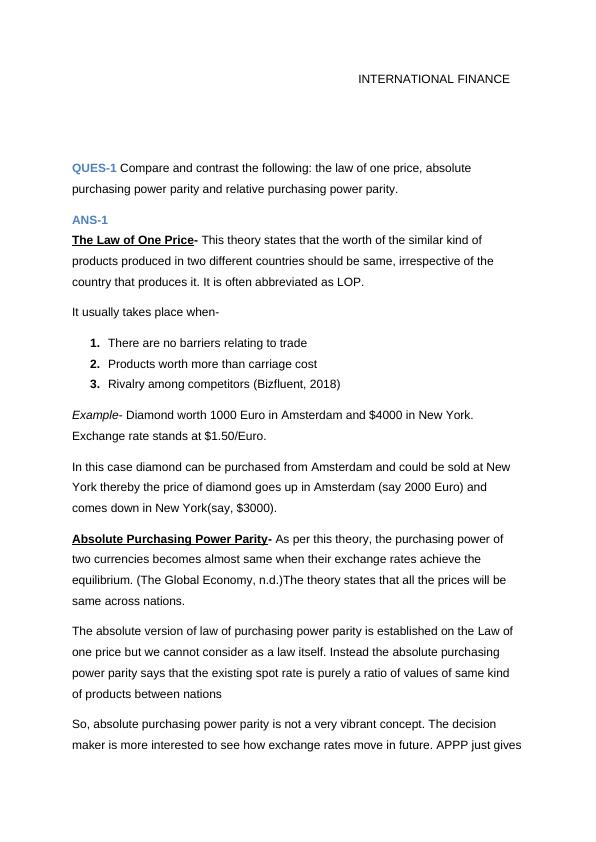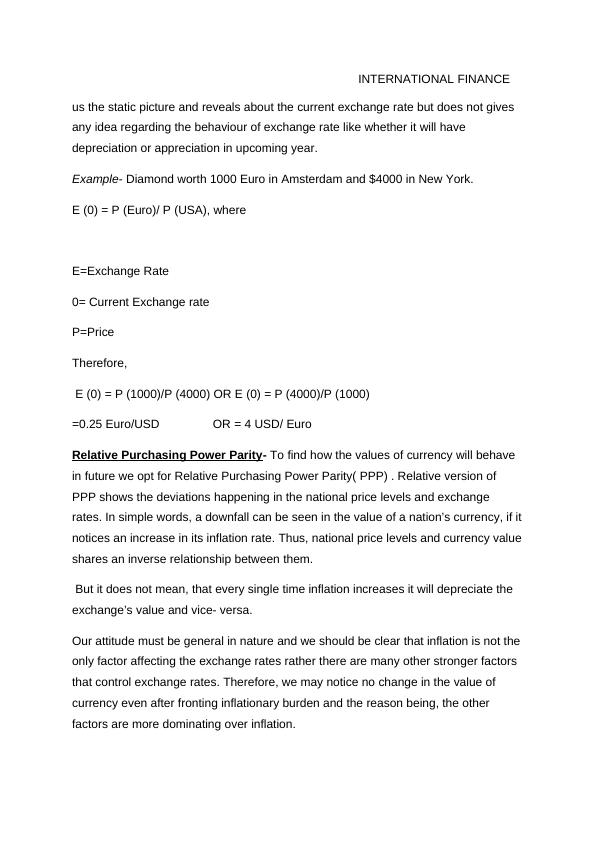Compare and Contrast: Law of One Price, Absolute Purchasing Power Parity, and Relative Purchasing Power Parity
Added on 2023-01-17
7 Pages1529 Words80 Views
Running Head: INTERNATIONAL FINANCE
INTERNATIONAL FINANCE
INTERNATIONAL FINANCE

INTERNATIONAL FINANCE
QUES-1 Compare and contrast the following: the law of one price, absolute
purchasing power parity and relative purchasing power parity.
ANS-1
The Law of One Price- This theory states that the worth of the similar kind of
products produced in two different countries should be same, irrespective of the
country that produces it. It is often abbreviated as LOP.
It usually takes place when-
1. There are no barriers relating to trade
2. Products worth more than carriage cost
3. Rivalry among competitors (Bizfluent, 2018)
Example- Diamond worth 1000 Euro in Amsterdam and $4000 in New York.
Exchange rate stands at $1.50/Euro.
In this case diamond can be purchased from Amsterdam and could be sold at New
York thereby the price of diamond goes up in Amsterdam (say 2000 Euro) and
comes down in New York(say, $3000).
Absolute Purchasing Power Parity- As per this theory, the purchasing power of
two currencies becomes almost same when their exchange rates achieve the
equilibrium. (The Global Economy, n.d.)The theory states that all the prices will be
same across nations.
The absolute version of law of purchasing power parity is established on the Law of
one price but we cannot consider as a law itself. Instead the absolute purchasing
power parity says that the existing spot rate is purely a ratio of values of same kind
of products between nations
So, absolute purchasing power parity is not a very vibrant concept. The decision
maker is more interested to see how exchange rates move in future. APPP just gives
QUES-1 Compare and contrast the following: the law of one price, absolute
purchasing power parity and relative purchasing power parity.
ANS-1
The Law of One Price- This theory states that the worth of the similar kind of
products produced in two different countries should be same, irrespective of the
country that produces it. It is often abbreviated as LOP.
It usually takes place when-
1. There are no barriers relating to trade
2. Products worth more than carriage cost
3. Rivalry among competitors (Bizfluent, 2018)
Example- Diamond worth 1000 Euro in Amsterdam and $4000 in New York.
Exchange rate stands at $1.50/Euro.
In this case diamond can be purchased from Amsterdam and could be sold at New
York thereby the price of diamond goes up in Amsterdam (say 2000 Euro) and
comes down in New York(say, $3000).
Absolute Purchasing Power Parity- As per this theory, the purchasing power of
two currencies becomes almost same when their exchange rates achieve the
equilibrium. (The Global Economy, n.d.)The theory states that all the prices will be
same across nations.
The absolute version of law of purchasing power parity is established on the Law of
one price but we cannot consider as a law itself. Instead the absolute purchasing
power parity says that the existing spot rate is purely a ratio of values of same kind
of products between nations
So, absolute purchasing power parity is not a very vibrant concept. The decision
maker is more interested to see how exchange rates move in future. APPP just gives

INTERNATIONAL FINANCE
us the static picture and reveals about the current exchange rate but does not gives
any idea regarding the behaviour of exchange rate like whether it will have
depreciation or appreciation in upcoming year.
Example- Diamond worth 1000 Euro in Amsterdam and $4000 in New York.
E (0) = P (Euro)/ P (USA), where
E=Exchange Rate
0= Current Exchange rate
P=Price
Therefore,
E (0) = P (1000)/P (4000) OR E (0) = P (4000)/P (1000)
=0.25 Euro/USD OR = 4 USD/ Euro
Relative Purchasing Power Parity- To find how the values of currency will behave
in future we opt for Relative Purchasing Power Parity( PPP) . Relative version of
PPP shows the deviations happening in the national price levels and exchange
rates. In simple words, a downfall can be seen in the value of a nation’s currency, if it
notices an increase in its inflation rate. Thus, national price levels and currency value
shares an inverse relationship between them.
But it does not mean, that every single time inflation increases it will depreciate the
exchange’s value and vice- versa.
Our attitude must be general in nature and we should be clear that inflation is not the
only factor affecting the exchange rates rather there are many other stronger factors
that control exchange rates. Therefore, we may notice no change in the value of
currency even after fronting inflationary burden and the reason being, the other
factors are more dominating over inflation.
us the static picture and reveals about the current exchange rate but does not gives
any idea regarding the behaviour of exchange rate like whether it will have
depreciation or appreciation in upcoming year.
Example- Diamond worth 1000 Euro in Amsterdam and $4000 in New York.
E (0) = P (Euro)/ P (USA), where
E=Exchange Rate
0= Current Exchange rate
P=Price
Therefore,
E (0) = P (1000)/P (4000) OR E (0) = P (4000)/P (1000)
=0.25 Euro/USD OR = 4 USD/ Euro
Relative Purchasing Power Parity- To find how the values of currency will behave
in future we opt for Relative Purchasing Power Parity( PPP) . Relative version of
PPP shows the deviations happening in the national price levels and exchange
rates. In simple words, a downfall can be seen in the value of a nation’s currency, if it
notices an increase in its inflation rate. Thus, national price levels and currency value
shares an inverse relationship between them.
But it does not mean, that every single time inflation increases it will depreciate the
exchange’s value and vice- versa.
Our attitude must be general in nature and we should be clear that inflation is not the
only factor affecting the exchange rates rather there are many other stronger factors
that control exchange rates. Therefore, we may notice no change in the value of
currency even after fronting inflationary burden and the reason being, the other
factors are more dominating over inflation.

End of preview
Want to access all the pages? Upload your documents or become a member.
Related Documents
The International Financelg...
|13
|2586
|14
Purchasing Power Parity (PPP) | FIN9026Mlg...
|34
|6385
|168
Theory of Purchasing Power Parity (PPPT)lg...
|11
|2671
|235
